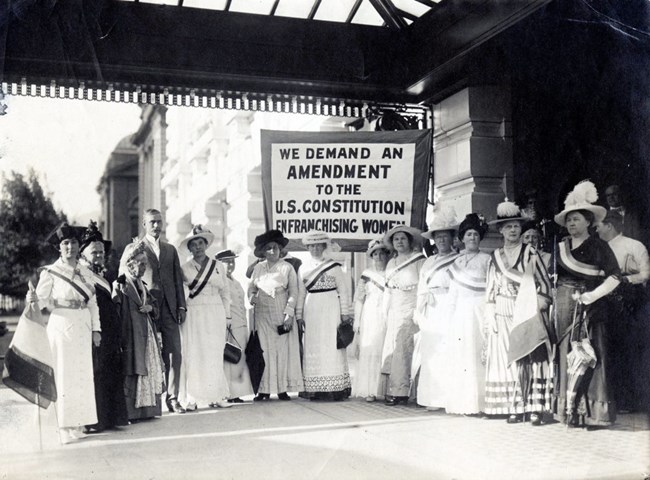Last updated: May 30, 2021
Article
Women's Suffrage in Utah

Photo courtesy of the National Woman’s Party
Polygamy is essential to understanding the history of women’s suffrage in Utah. In 1850 President Millard Fillmore selected Brigham Young, the president of the Church of Jesus Christ of Latter-day Saints, as governor of the newly formed Utah Territory. The appointment of a religious official to political office raised eyebrows across the nation; so did polygamy, the practice of having more than one wife.
In the 1860s, well-connected easterners began to view Utah Territory as an ideal place to experiment with voting rights for women: if women were enfranchised, then surely they would rise up against what many Americans saw as the oppressive institution of “plural marriage.” (Anna Dickenson, a suffrage advocate who toured the country speaking against polygamy, even compared it to slavery.) Some also hoped that women voters would loosen the church’s hold on Utah by electing “Gentiles”—what Mormons called non-Mormons—to political office.
The church’s attitude towards suffrage was complicated. Mormons had allowed women to vote on congregational matters since 1831, although their votes served only to sustain decisions made in private clergy meetings (where women were not allowed). The first constitution adopted in Utah, in 1849, granted voting rights only to white males. Why, then, did women’s suffrage come so easily in Utah—a territory with no real organized suffrage campaign? Unlike Wyoming, which enfranchised women in 1869, Utah did not need voting rights to attract more women to the territory (it already had a balanced sex ratio). Like Wyoming, however, public relations played a major role in Utah’s adoption of equal suffrage.
Utah’s leaders desired statehood and, by granting women the vote, they hoped to dispel the idea that Mormon society oppressed women. Prominent Utahns also saw an opportunity to enlist the help of eastern suffrage organizations. George Q. Cannon, the Mormon editor of the Deseret News and a husband to four wives (in 1870), described the female vote as “a most excellent measure” that “brought to our aid the friends of women suffrage.” Changing times in the American West likely played a role, as well. Some historians argue the completion of the railroad to Salt Lake City in 1869 spurred prominent Utahns into enfranchising more Mormons, thereby guarding against an invasion of outsiders. Mormon men likely surmised that the territory’s women would uphold church doctrine at the ballot box.
Whatever the motivations, Territorial Secretary S. A. Mann signed an act granting roughly 43,000 Utahn women (those at least 21 years old, and either US citizens themselves or the wife, daughter, or widow of one) the right to vote on February 12, 1870. Six months later, the women of Utah voted in territorial elections. In the process, they helped reelect William H. Hooper, a territorial representative known as an aggressive advocate for women’s suffrage; Brigham Young, however, attributed Hooper’s reelection to the fact that he had defended polygamy in Congress. Once again, the issues of suffrage and polygamy remained connected.
Yet the advent of women’s suffrage in Utah did little to change widespread attitudes toward the territory and its religious majority. National sentiment led to the 1887 Edmunds-Tucker Act, which disenfranchised polygamous men and all women (even those that did not practice polygamy) in the territory. In response, Utahn women formed suffrage organizations across the state, giving prominent positions to women involved in monogamous marriages. The church soon issued the 1890 Manifesto, which declared an end to polygamy. The new Utah constitution, guaranteeing the rights of women to vote and hold office, was adopted in November 1895; with the polygamy issue seemingly settled, statehood—and the distinction of becoming the third state with equal suffrage (after Wyoming and Colorado)— followed in January 1896. Women throughout the US gained the right to vote with ratification of the 19th Amendment on August 18, 1920; however, many women of color still faced obstacles to exercising this right.
Thomas G. Alexander, “An Experiment in Progressive Legislation: The Granting of Woman Suffrage in Utah in 1870,” Utah Historical Quarterly 38, no. 1 (Winter 1970): 24, 27, 29-30.
Beverly Beeton, “Women Suffrage in Territorial Utah,” Utah Historical Quarterly 46, no. 2 (Spring 1978): 102-4, 106-7, 112-13, 115-18, 120.
Kathryn M. Daynes, “Single Men in a Polygamous Society: Male Marriage Patterns in Manti, Utah,” Journal of Mormon History 24, no. 1 (Spring 1998): 90.
Kathryn L. Mackay, “Women in Politics: Power in the Public Sphere,” in Patricia Lyn Scott, Linda Thatcher, and Susan Allred Whetstone (eds.), Women in Utah History: Paradigm or Paradox? (Logan: Utah State University Press, 2005), 363-64, 367.
Sandra Myres, Westering Women and the Frontier Experience, 1800-1915 (Albuquerque: University of New Mexico Press, 1982), 221-23.
Jean Bickmore White, “Women’s Suffrage in Utah,” in Allan Kent Powell (ed.), Utah History Encyclopedia (Salt Lake City: University of Utah Press, 1994); accessed via Utah History to Go from <https://historytogo.utah.gov/womens-suffrage-utah/>.


